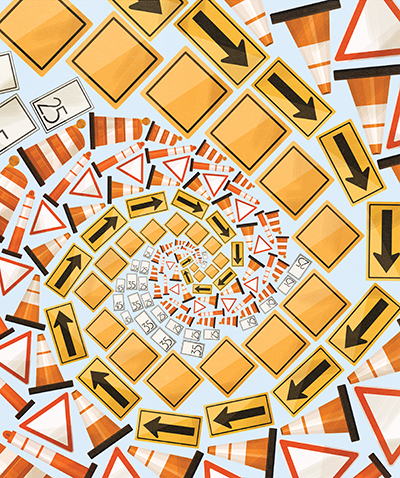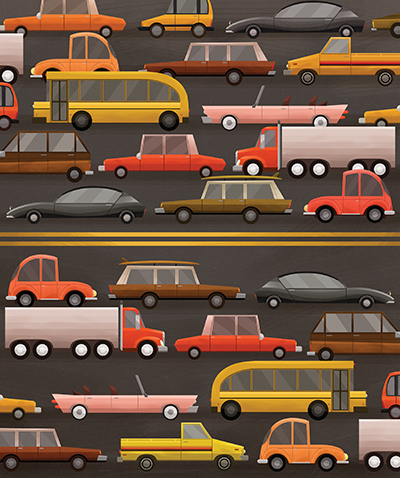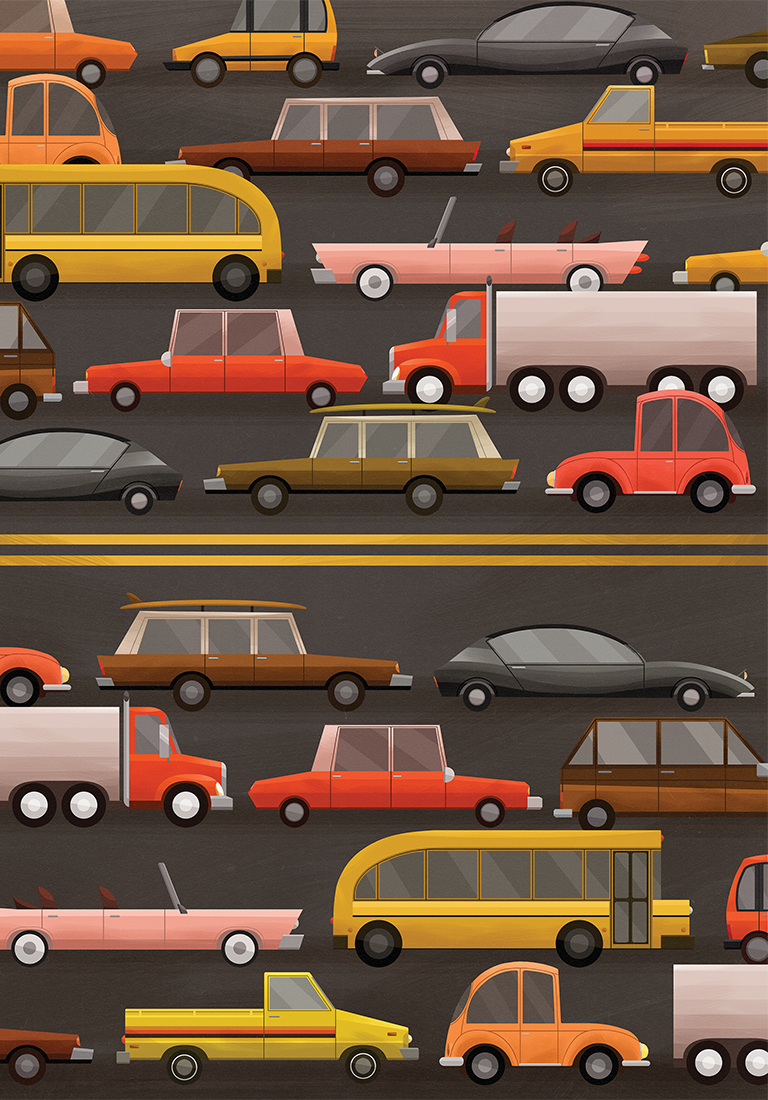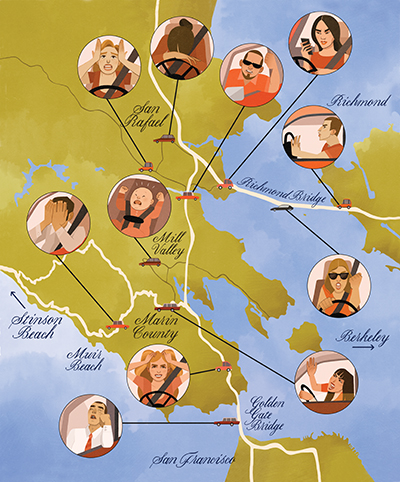Everyone in Marin has an awful traffic story and here is mine: one Thursday afternoon in January, I left downtown San Rafael at 2:45 p.m. for a 4 p.m. appointment near Oakland’s Caldecott Tunnel. Because it was mid-afternoon, I thought I’d given myself plenty of time. But traffic along 580 was so congested it took me an hour and 15 minutes just to reach the Richmond–San Rafael Bridge. And then it took me another full hour to reach Oakland.
WHEN I GRIPED about the trip to friends afterward, floodgates opened: everyone wanted to talk about how bad traffic was in Marin. They also offered theories on why, ranging from the county’s population growth (not correct) to whispers that people from the East Bay were driving over and parking at the Larkspur Ferry Terminal in the dark to go to San Francisco (possibly). One friend even suggested that we start a special Twitter hashtag for Marin, #traf—ked, which seemed to sum things up.
It’s not an imagined problem; congestion has gotten worse in Marin. Traffic has risen 5 percent along Highway 101 in the past 10 years and 18 percent along Highway 37. Golden Gate Bridge traffic has jumped from 38 million vehicles in 2011 to more than 40 million in 2015. And Richmond–San Rafael Bridge traffic has jumped from 12.2 million (westbound only) in 2011 to nearly 14.5 million vehicles in 2015.
Surface roads are crazy, too. Trips that used to take 8 minutes, 57 seconds during the morning commute along Tiburon Boulevard in 2012 now take 14 minutes, 3 seconds. Sir Francis Drake, one of the county’s most congested corridors, is a perennial parking lot.
What’s going on? “The simplest answer is, ‘It’s the economy, stupid,’ ” says Dianne Steinhauser, executive director of the Transportation Authority of Marin (TAM). “We’re experiencing a very healthy economy right now, which means more jobs and more traveling.”
Robert Eyler, Ph.D., director of the Center for Regional Economic Analysis at Sonoma State University, agrees. “San Francisco has once again become a vibrant, global business capital,” he says, “which means there’s going to be more southbound traffic in the morning and northbound at night.”
It’s not just high-paid tech execs clogging the roads, though; it’s also the nannies, gardeners and contractors they employ (not to mention the countless Amazon deliveries). In Mill Valley alone, building permits have jumped from 745 in 2010 to 1,154 in 2014, the latest year for which statistics are available — one of the many reasons East Blithedale is a sea of red brake lights.
Another key reason, however, is this: though Mill Valley’s roads were designed for six vehicle trips per day per household, the average household now generates more than 11. In fact, the city has 3,000 more registered cars than it has driving age residents.
Marin also has considerable traffic from the East Bay and Sonoma. Many of these drivers are the grocery tellers, gas station employees and restaurant servers who can’t afford to live in Marin’s high-cost housing. But 12 percent of our traffic, according to TAM, is “pass-through”: East Bay commuters trying to avoid the Bay Bridge by driving to San Francisco via Marin.

The good news is that a lot of smart people are working to fix the problems, and they’re moving quickly (by transportation standards) on a variety of solutions, the most significant being a new, third lane on the Richmond–San Rafael Bridge.
The centerpiece of the $74 million project is a plan to convert the shoulder of the lower, eastbound deck to a third lane during peak afternoon hours, as well as build a bike/ pedestrian path on the upper deck. Planners expect that the improvements, slated for completion in August 2017, will substantially reduce delays, often even to zero.
Why not open the lane now? It’s not that simple (actually, nothing traffic-related is simple). Ramp metering needs to be installed, but most pressingly, there’s a curved retaining wall at the eastern edge of the bridge that needs to be moved. “It’s a line-of-sight issue,” says Bill Whitney, TAM principal project delivery manager. “It could be a safety hazard if you put traffic on the shoulder moving at high speeds around that curve.”
Assemblyman Marc Levine has been pushing to open the lane immediately and has suggested to transportation officials that they lower the speed limit during commute hours to accommodate the line-of-sight issues. “It would be faster to be going 35 to 45 mph,” says Levine, “than to be sitting in traffic.” He adds, however, that officials are “stuck between a rock and a hard place,” because the bridge is contractually obligated, for the short-term, to provide parking for the equipment of the contractors that are working on it. “I think that lane needs to be used for traffic, not storage,” says Levine.
Still, what’s the benefit of a free-flowing bridge if no one can get to it? At the moment, the two northbound approaches to the bridge — Sir Frances Drake and Bellam boulevards — are positively Kafkaesque on a weekday afternoon, a problem TAM is trying to address. They’ve drawn up plans to relocate the “lane drop” (where the road narrows from two lanes to one) near Larkspur Landing 1,000 feet to the east, to help traffic flow more freely. And they’re hoping to reconfigure the Bellam intersection to minimize weaving as drivers approach 580. “We’re trying to have all of this done in summer of 2017, to coincide with the bridge lane opening,” Steinhauser says.
There’s also a $13 million county project in the works to “rehabilitate” Sir Francis Drake, from 101 to Ross, including repaving the road, trimming some wide lanes and realigning intersection traffic. Work is due to begin in 2017.
The proposed upgrades, however, are being met with some skepticism. “I was at a Marin Transit meeting listening to the report on the Sir Francis Drake projects,” says Stephanie Moulton-Peters, Mill Valley councilwoman, “and it felt like déjà vu all over again. It’s the same narrow roads as we have in Mill Valley, the same choke points, too many cars trying to go everywhere. We have these narrow little roads that weren’t meant to carry this kind of traffic.”
As for the snail-like crawl along 101: in 2018, Caltrans will begin installing ramp-metering along the northbound on-ramps from Spencer Avenue to Sir Frances Drake. When Marin residents hear the words “ramp metering,” they grow nervous: “The biggest fear,” Steinhauser says, “is that traffic will be backed up on the local roads.” To ensure that doesn’t happen, Caltrans is installing a metering system with pavement sensors to measure when surface roads become congested. When they do, the meters automatically speed up the rate at which cars can enter the freeway.
So, yes, Marin residents might have to wait a full minute to get on the freeway, but once they’re on, the time savings could be substantial. After San Mateo County installed ramp metering in late 2007/early 2008, drivers saw an average 18 percent time savings during the morning commute.
What’s more, Steinhauser says, ramp metering gets to the root of the problem, which is that Marin’s traffic has outgrown its infrastructure. Highway 101 was designed to handle 7,500 cars per hour, but as drivers get on northbound from Mill Valley, Tiburon, Corte Madera and Larkspur, the highway exceeds its capacity at peak hours. Thus, staggering congestion.
The best way to reduce traffic, of course, would be to get cars off the road, and there are a number of efforts to do so. The most successful, by far, has been Safe Routes to School (SR2S), the nation’s first such program when it was implemented in 2001. “School traffic is a huge component of our congestion,” says David Parisi, of Parisi Transportation Consulting, a consultant for TAM. “In fact, in some places in the county, there is as much traffic after school as there is in the evening commute.”
As a remedy, SR2S has worked with schools to encourage kids to walk, bike or ride the bus to school. The program pays for crossing guards, while another program, Safe Pathways, has helped install important infrastructure like lighted crosswalks. Fifty-five schools now participate in SR2S, and in areas surrounding some schools traffic has been reduced by as much as 20 percent. This year, Tiburon and Belvedere (with parents’ financial help) also began a pilot program utilizing seven yellow school buses, aiming to get traffic from three schools off Tiburon Boulevard. Mill Valley is launching a similar program in 2016–17.
The Marin County Bike Coalition has, meanwhile been pushing for completion of a north-south greenway, which would create designated multiuse paths and bike lanes for cyclists from the Golden Gate Bridge to Petaluma. Several recent infrastructure improvements, including the Cal Park Tunnel in San Rafael and the Central Marin Ferry Connection Multi-Use Pathway, are helping them get closer to the goal of getting more cars off the road.

Marin has public transportation, too, but residents here have never embraced public transit the way, say, people in New York’s Westchester County have (to be fair, the New York metropolitan area’s system is far more comprehensive). While the Larkspur and Sausalito ferries have seen an increase of 5,719 weekday passengers in 2005 to 8,219 in 2015 (see: the always-full Larkspur parking lot), Marin Transit’s bus ridership has essentially remained steady. The SMART train could make public transit more attractive and take as many as 5,000 vehicles — or more — off the roads per day. But the real proof will be when SMART starts its initial passenger run in late 2016, from Larkspur to the Sonoma County Airport.
Here’s the funny thing, though: as much as Marin residents complain about traffic, we’re not even close to having the worst congestion in the Bay Area. That distinction, as ranked by the Metropolitan Transportation Commission, goes to the westbound morning commute along I-80 between Hercules and Oakland. Marin doesn’t even make the top 10; our highest ranking is number 11, for the southbound 101 morning commute between Rowland Boulevard and Lincoln Avenue.
The natural inclination, when stuck in traffic, is to look around and wonder what all these other jerks are doing on the road. But as Moulton-Peters emphasized at a Mill Valley City Council meeting last November, drivers are looking in the wrong place. When the council presented its traffic research findings, she recalls, “Our citizens were looking at us as if we were going to find a magic bullet for the problem.” So she rose from her chair, pulled a mirror from the wall and, staring into it, said, “You want to know where the traffic is coming from? We are the traffic. We have to find ways to reduce the number of cars on our roads. We’re all in this together.
This article originally appeared in Marin Magazine’s print edition under the headline: “Traffic Nightmare.”



